AMD's Richland vs. Intel's Haswell GPU on the Desktop: Radeon HD 8670D vs. Intel HD 4600
by Anand Lal Shimpi on June 6, 2013 12:00 PM ESTCompute
As always we'll start with our DirectCompute game example, Civilization V, which uses DirectCompute to decompress textures on the fly. Civ V includes a sub-benchmark that exclusively tests the speed of their texture decompression algorithm by repeatedly decompressing the textures required for one of the game’s leader scenes. While DirectCompute is used in many games, this is one of the only games with a benchmark that can isolate the use of DirectCompute and its resulting performance.
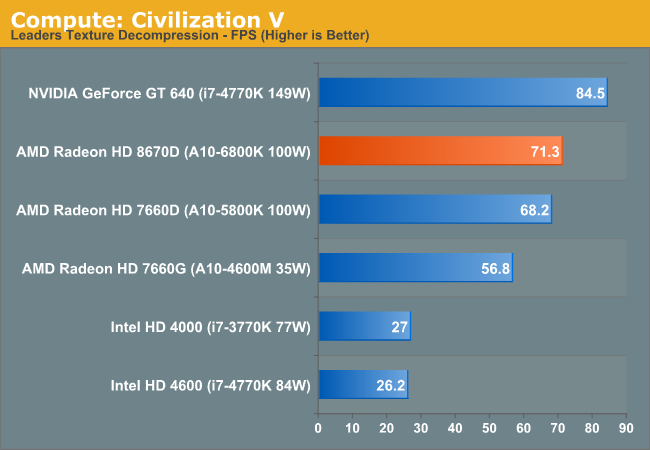
AMD does extremely well in our sole DirectCompute test, outperforming Intel's latest desktop graphics solution by a huge margin.
Our next benchmark is LuxMark2.0, the official benchmark of SmallLuxGPU 2.0. SmallLuxGPU is an OpenCL accelerated ray tracer that is part of the larger LuxRender suite. Ray tracing has become a stronghold for GPUs in recent years as ray tracing maps well to GPU pipelines, allowing artists to render scenes much more quickly than with CPUs alone.
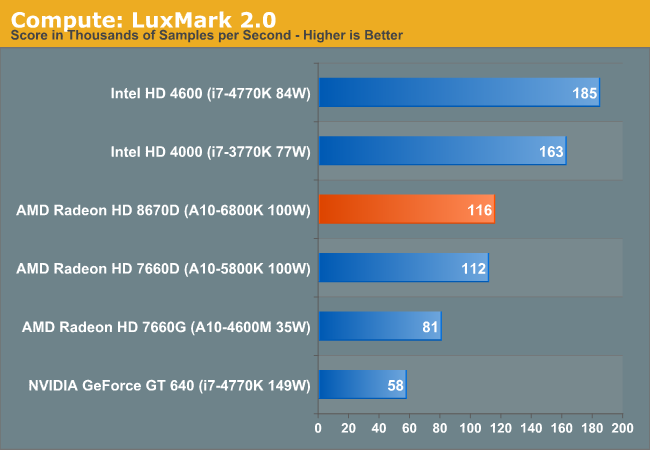
Haswell GT2's OpenCL performance can be very good, which is what we're seeing here. HD 4600 ends up being almost 60% faster than the Radeon HD 8670D.
Our 3rd benchmark set comes from CLBenchmark 1.1. CLBenchmark contains a number of subtests; we’re focusing on the most practical of them, the computer vision test and the fluid simulation test. The former being a useful proxy for computer imaging tasks where systems are required to parse images and identify features (e.g. humans), while fluid simulations are common in professional graphics work and games alike.
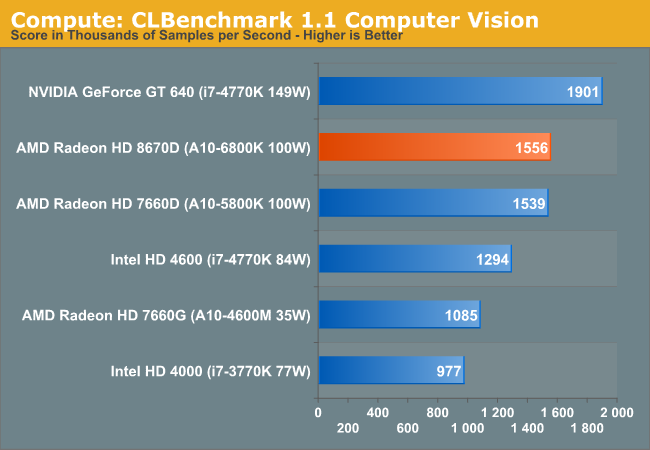
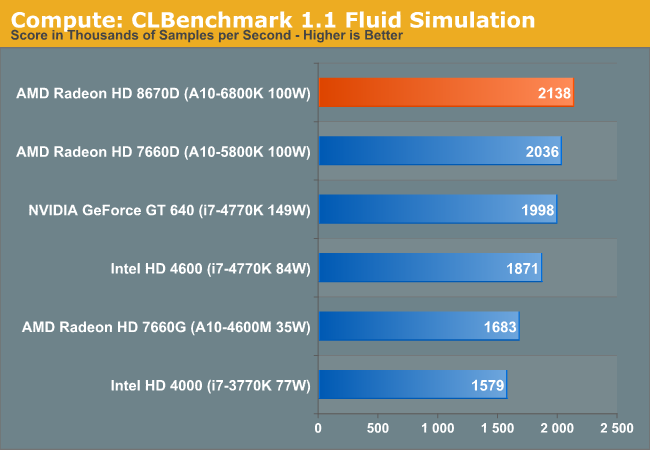
AMD and Intel trade places once again with CLBenchmark. Here, Richland does extremely well.
Our final compute benchmark is Sony Vegas Pro 12, an OpenGL and OpenCL video editing and authoring package. Vegas can use GPUs in a few different ways, the primary uses being to accelerate the video effects and compositing process itself, and in the video encoding step. With video encoding being increasingly offloaded to dedicated DSPs these days we’re focusing on the editing and compositing process, rendering to a low CPU overhead format (XDCAM EX). This specific test comes from Sony, and measures how long it takes to render a video.
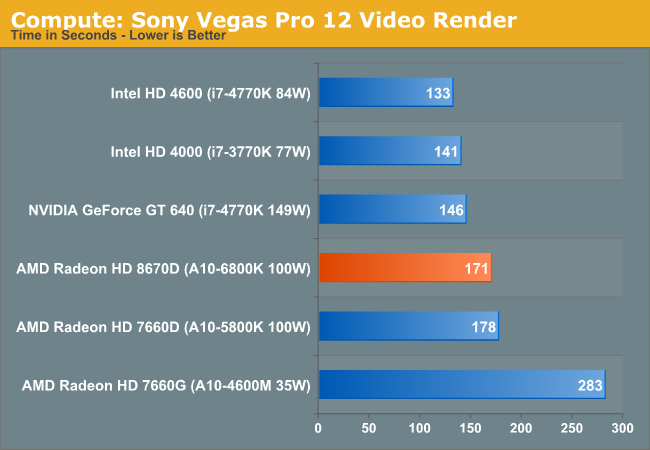
The last compute test goes to Intel, although the two put up a good fight across the entire suite.










102 Comments
View All Comments
FriendlyUser - Thursday, June 6, 2013 - link
I see your point. But how many of these users need the CPU performance of the 4770? Do you think that the average business user needs a 4770 to do excel and answer emails? Will he even notice the difference? I can't really show you statistics, but I imagine that a big part of demanding users are in fact gamers.JDG1980 - Thursday, June 6, 2013 - link
I understand why the average Intel CPU has an integrated graphics processor, but the K-series parts are specifically targeted at enthusiasts. Why don't they omit the IGP from those?Gigaplex - Thursday, June 6, 2013 - link
QuickSync is one possible answer. Another is that enthusiasts tend to swap out GPUs more frequently than other demographics so having a basic iGPU can come in handy for diagnostics now and then. And not all enthusiasts are gamers.dbcoopernz - Thursday, June 6, 2013 - link
Are you going to look at HTPC performance for Richland? e.g. madVR, refresh rate timings.RoyYoung - Thursday, June 6, 2013 - link
Thanks for the squeezing this out in such a short turn around. However I just don't think this is useful or new. I have never met anyone in the market for an i7 xxxxk cpu looking to play AAA game using the iGPU, have you? The iGPU in the i7 is just a bonus because it shares a die with the mobile counterpart, and gives you quick sync if prefer speed over quality in your transcoding.In today's market, the only reason to invest in the space, noise , heat, and money for a desktop gaming PC is to play games at 1080p or higher. Just get a Xbox if you need 720p. From the benchmarks its clear that neither the i-7 Haswell nor the Richland are playable at 900p let alone 1080p. On the other hand, the same tests at 768p on mobile Richland and Haswell parts makes perfect sense given the typical resolution and thermal of laptops. Given the power usage delta between the AMD and Intel desktop parts, I suspect the race is going to be a lot closer in the laptop race.
kallogan - Thursday, June 6, 2013 - link
Richland is really lame. I mean it brings barely peanuts over Trinty. Why even release that. And it's expensive. Desktop parts are really boring right now.kyuu - Thursday, June 6, 2013 - link
I'd be interested in seeing if you can get a stable RAM clock @ 2400MHz, and if so, how much Richland scales with that. Hope you take a look at when you do the more thorough piece.johnny_boy - Thursday, June 6, 2013 - link
APUs scale very well with faster memory almost regardless of timings. I'd like to see Richland benchmarks with DDR3 2400, though I can already make a pretty good guess of what those figures would look like.Samastrike - Thursday, June 6, 2013 - link
So what I'm seeing here is very similar GPU performance to trinity for $20 more? Except in 3Dmark06 where it suddenly has a huge jump. Doesn't strike me as worth it.firewall597 - Thursday, June 6, 2013 - link
I'm a little disappointed that AMD cared to release this as a new model generation at all. There's barely enough argument to avoid throwing the "rebranding" flag. Shoulda just fit the upclocked parts appropriately into the current gen's numbering and adjusted prices accordingly.The effort is appreciated always, but the marketing is somewhat misleading from the surface.